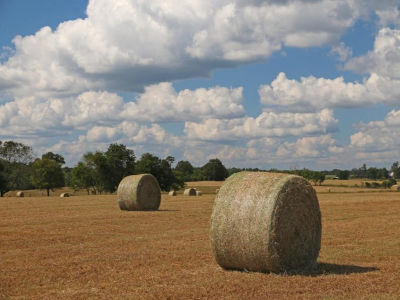By Justin Miller
With winter just around the corner, Alabama cattle producers should begin planning for their herd’s winter feeding needs.
Farmers must consider the herd’s nutritional needs and compare that to their supply of forages, both stored and grazing. Understanding need versus supply will help producers plan for a successful winter.
Nutritional Requirements
Luke Jacobs, a graduate research assistant in the Auburn University department of animal sciences, said producers must first know their herd’s nutritional requirements.
“This determination is based on the herd’s stage of production,” Jacobs said. “Production stage impacts several management decisions for your cattle. Average cow size can also be useful in accurately predicting forage intake and nutrient requirements.”
Herd nutritional requirements vary greatly depending on herd type. For example, a nonlactating, late-gestation bred cow has the lowest nutrient requirement of any production phase, whereas cows in other phases have higher requirements.
“Cows have the highest nutrient requirements following parturition,” said Maggie Justice, also a graduate research assistant in the department of animal sciences. “This is due to the onset of lactation and repairing of the reproductive tract to re-breed efficiently and in a timely manner. In this stage, supplementation or access to high-quality forages is often required.”
Find more information on determining a herd’s nutritional requirements in the Alabama Extension publication Nutrient Requirements of Beef Cattle, ANR-0060.
Determining Needed Forages
Once a producer determines the herd nutritional requirements, then they can determine whether there are sufficient forages.
Leanne Dillard, an Alabama Extension forage specialist, said there are several factors to consider.
“In order to determine winter forage needs, you must consider the number of animals you have and how many days you will need to feed hay or graze during the winter,” Dillard said.
Grazing Forages
There may be an opportunity to implement grazing as a part of the winter feeding season based on system type. Herds in central and north Alabama with tall fescue grazing systems can graze into December with fall fertilizer applications.
“You will possibly need to feed hay starting in January or early February,” she said. “If it is not too cold, the tall fescue will begin growing again in mid-February to early March.”
Dillard said the bermudagrass and bahiagrass goes dormant in late November in south Alabama. These grasses will stay dormant until late March or April (bahiagrass) or even into May (bermudagrass).
Producers who overseeded with a cool-season annual should be able to begin grazing in mid-February and continue through May. These cool-season annuals may include small grains, annual ryegrass or crimson clover.
“The grazing starting date will depend on the planting date of the cool-season annuals,” she said. “This will leave six to eight weeks of hay feeding in December and January. If cool-season annuals were planted early enough, this window could be reduced to four to six weeks or less.”
To help extend grazing in winter feeding schedules, Dillard said producers should utilize rotational grazing. This will help increase grazing efficiency and stretch out the grazing season.
“The most important thing is to avoid over-grazing or make a muddy field during hay feeding,” Dillard said. “This will slow the green-up in the spring and reduce field productivity.

Stored Forages
When estimating stored forage needs, producers have to look at not only the quantity but also the quality of the forages. The makeup of a bale of hay, as well as the storage conditions, makes a difference.
“It is extremely important to know the size or weight of your bales,” Dillard said. “When calculating estimated dry matter intake per cow or per herd, knowing how much each bale weighs will assist you in knowing exactly how much to feed the cows.”
Dillard said hay and baleage are expensive to produce. Producers should protect the investment with proper storage.
“Hay should be stored under some sort of cover,” she said. “Even if it is stored outside, the bales should be place on gravel, or a well-drained area, and covered with a tarp.”
Bale storage determines how much hay will be consumed. Hay stored outside can have a 30 percent wastage rate, while hay stored under a barn has a less than five percent wastage rate.
By reducing the percentage of bale waste, the needed quantity of bales will decrease. In addition to proper storage, feeding only what animals can consume in a day will help reduce wastage.
Click here to see more...